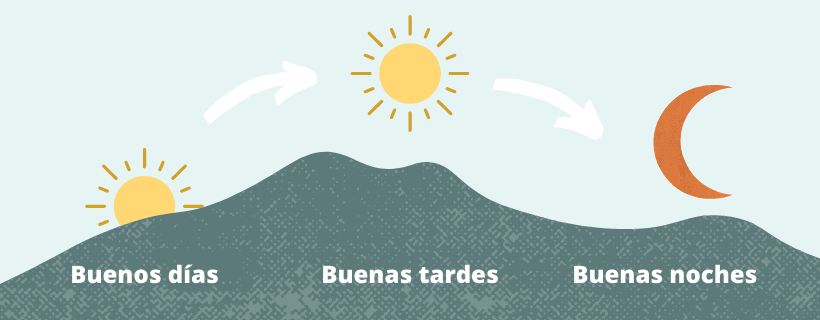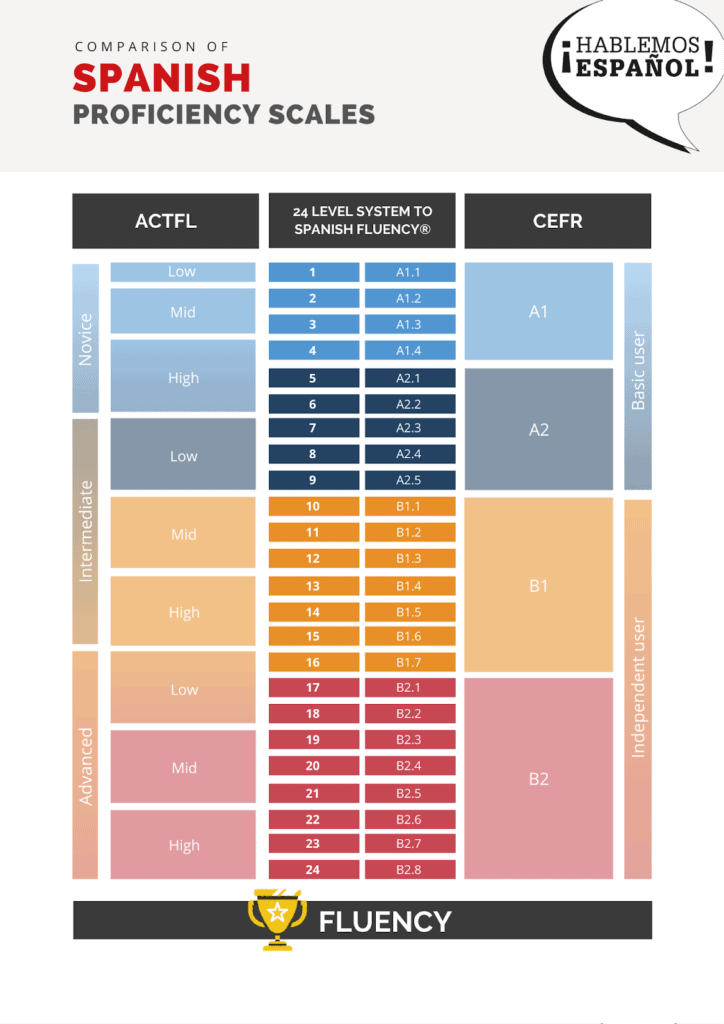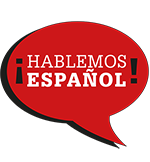Greetings in Spanish and Other Common Phrases for Daily Life

-
Save
10 Greetings in Spanish and other Common Phrases for Daily Life
Are you currently learning Spanish or are you planning a trip to Spain?
Meeting someone new in a foreign country can be stressful. Especially if you don’t speak the language very well. That’s why it is always a good idea to know some basic phrases in the local language.
This article provides you with some useful and common Spanish expressions for daily life. You will learn how to greet someone, say goodbye, introduce yourself and ask for directions, among other things.
Take a look at the 10 most common greetings in Spanish and other useful phrases you can use when meeting someone new.
Table of Contents
1. Meeting Someone New
1.1 Greetings in Spanish
1.2 How Are You in Spanish
1.3 Introductions in Spanish
1.4 Goodbyes in Spanish
1.5 Asking For Clarification in Spanish
2. Where Are You From?
3. Asking for Directions
3.1 Apologizing in Spanish
3.2 Asking For Help in Spanish
3.3 Asking For Directions in Spanish
4. Special Occasions
1. Meeting Someone New
Level 1 (A1.1 / Novice Low)
Greeting someone, introducing yourself and saying goodbye in Spanish will be a piece of cake with the following expressions.
1.1 Greetings in Spanish
Greetings exist in all cultures and are not quite different from one language to another. When you are greeting someone in Spanish you just have to pay attention to forms (formal or informal) and gender in some expressions.
You want to greet someone when entering a shop, restaurant or building, but don’t know how? Use the following phrases to say hello to someone in Spanish.
- [mp3j track="https://letsspeakspanish.com/wp-content/uploads/2022/07/hola.mp3" title="" ind="n" volslider="n" flow="y"] Hola - Hello
- [mp3j track="https://letsspeakspanish.com/wp-content/uploads/2022/07/Buenos-días.mp3" title="" ind="n" volslider="n" flow="y"]Buenos días - Good morning
- [mp3j track="https://letsspeakspanish.com/wp-content/uploads/2022/07/Buenas-tardes.mp3" title="" ind="n" volslider="n" flow="y"]Buenas tardes - Good afternoon
- [mp3j track="https://letsspeakspanish.com/wp-content/uploads/2022/07/Buenas-noches.mp3" title="" ind="n" volslider="n" flow="y"]Buenas noches - Good evening

-
Save
Also check:
In Spanish, we say Buenos días from 6 am to 12 pm (before lunch).
People say Buenas tardes after having lunch until 8 pm (approximately).
Finally, we say Buenas noches from 9 pm on.
Also take a look at the following options:
- [mp3j track="https://letsspeakspanish.com/wp-content/uploads/2022/07/Mucho-gusto.mp3" title="" ind="n" volslider="n" flow="y"]Mucho gusto - It’s nice to meet you
- [mp3j track="https://letsspeakspanish.com/wp-content/uploads/2022/07/Encantado.mp3" title="" ind="n" volslider="n" flow="y"]Encantado, -a - Nice to meet you
- [mp3j track="https://letsspeakspanish.com/wp-content/uploads/2022/07/Bienvenido.mp3" title="" ind="n" volslider="n" flow="y"]Bienvenido, -a - Welcome
Want more practice? Listen to our podcast about formal and informal greetings in Spanish ⬇️:
Formal and Informal Greetings in Spanish
1.2 How Are You in Spanish
After greeting someone, the following step is to ask how they are. This is almost a cliché to start a conversation in any language. The most common answer is to say you are fine, even if you are not, unless you are greeting someone close to you.
- [mp3j track="https://letsspeakspanish.com/wp-content/uploads/2022/07/¿Cómo-estás_.mp3" title="" ind="n" volslider="n" flow="y"]¿Cómo estás? -How are you? (informal)
- [mp3j track="https://letsspeakspanish.com/wp-content/uploads/2022/07/¿Cómo-está_.mp3" title="" ind="n" volslider="n" flow="y"]¿Cómo está? - How are you? (formal)
- [mp3j track="https://letsspeakspanish.com/wp-content/uploads/2022/07/¿Qué-hay-de-nuevo_.mp3" title="" ind="n" volslider="n" flow="y"]¿Qué hay de nuevo? - What's new? (informal)
- [mp3j track="https://letsspeakspanish.com/wp-content/uploads/2022/07/¿Qué-tal_.mp3" title="" ind="n" volslider="n" flow="y"]¿Qué tal? - How are you? (informal)
- [mp3j track="https://letsspeakspanish.com/wp-content/uploads/2022/07/¿Qué-tal-está_.mp3" title="" ind="n" volslider="n" flow="y"]¿Qué tal está? - How are you? (formal)
Cómo estás/Cómo está/Qué tal/Qué tal está
are two versions of the same question.
We use the informal one when talking to people we already know, such as friends, family,…
We use the formal form when talking to someone we don’t know, who is older than us or just to show respect and formality (maybe to your boss or doctor, for example).
What could you say if someone asks you one of the questions above?
- [mp3j track="https://letsspeakspanish.com/wp-content/uploads/2022/07/Estoy-estupendamente.mp3" title="" ind="n" volslider="n" flow="y"]Estoy estupendamente - I’m doing great
- [mp3j track="https://letsspeakspanish.com/wp-content/uploads/2022/07/Estoy-bien-gracias.mp3" title="" ind="n" volslider="n" flow="y"]Estoy bien, gracias - I’m good, thank you
- [mp3j track="https://letsspeakspanish.com/wp-content/uploads/2022/07/cansado.mp3" title="" ind="n" volslider="n" flow="y"]Estoy un poco cansado/a - I'm a little tired
- [mp3j track="https://letsspeakspanish.com/wp-content/uploads/2022/07/Estoy-mal.mp3" title="" ind="n" volslider="n" flow="y"]Estoy mal - I feel unwell
- [mp3j track="https://letsspeakspanish.com/wp-content/uploads/2022/07/enfermo.mp3" title="" ind="n" volslider="n" flow="y"]Estoy enfermo, -a - I’m sick
1.3 Introductions in Spanish
In some situations, for example when meeting the host of your residence, you will have to introduce yourself. Learn the next four sentences by heart to tell someone your name and to ask for someone’s name in Spanish.
- [mp3j track="https://letsspeakspanish.com/wp-content/uploads/2022/07/¿Cuál-es-tu-nombre_.mp3" title="" ind="n" volslider="n" flow="y"]¿Cuál es tu nombre? - What is your name? (informal)
- [mp3j track="https://letsspeakspanish.com/wp-content/uploads/2022/07/¿Cuál-es-su-nombre_.mp3" title="" ind="n" volslider="n" flow="y"]¿Cuál es su nombre? - What is your name? (formal)
- [mp3j track="https://letsspeakspanish.com/wp-content/uploads/2022/07/¿Cómo-te-llamas_.mp3" title="" ind="n" volslider="n" flow="y"]¿Cómo te llamas? - What is your name? (informal)
- [mp3j track="https://letsspeakspanish.com/wp-content/uploads/2022/07/¿Cómo-se-llama_.mp3" title="" ind="n" volslider="n" flow="y"]¿Cómo se llama? - What is your name? (formal)
- [mp3j track="https://letsspeakspanish.com/wp-content/uploads/2022/07/Mi-nombre-es.mp3" title="" ind="n" volslider="n" flow="y"]Mi nombre es X. - My name is X.
- [mp3j track="https://letsspeakspanish.com/wp-content/uploads/2022/07/Me-llamo.mp3" title="" ind="n" volslider="n" flow="y"]Me llamo X. - My name is X.
- [mp3j track="https://letsspeakspanish.com/wp-content/uploads/2022/07/Soy.mp3" title="" ind="n" volslider="n" flow="y"]Soy X. - I’m X.
Verb LLAMARSE
The verb we use to say our name or to ask someone’s name in Spanish is LLAMARSE.
This is a regular reflexive verb whose meaning is “to be called/named”.
The verb llamarse needs to be preceded by a reflexive pronoun, this is extremely important, otherwise, the verb will mean something else. Once you have the reflexive pronoun ready, you will need to add the correct ending to the verb, remember that verbs in Spanish take on different endings based on the subject.
Finally, after adding the pronouns and the endings, the conjugated verb will be like this:
Yo me llamo
Tú te llamas
Él/Ella/Usted se llama
Nosotros/Nosotras nos llamamos
Vosotros/Vosotras os llamáis
Ellos/Ellas/Ustedes se llaman
Do you want to learn more about introducing yourself or others in Spanish? Watch the following videos:
1.4 Goodbyes in Spanish
Are you leaving or do you simply want to end the conversation? Use these phrases to say goodbye to someone.
- [mp3j track="https://letsspeakspanish.com/wp-content/uploads/2022/07/Adiós.mp3" title="" ind="n" volslider="n" flow="y"]Adiós - Goodbye
- [mp3j track="https://letsspeakspanish.com/wp-content/uploads/2022/07/Hasta-luego.mp3" title="" ind="n" volslider="n" flow="y"]Hasta luego - See you later
- [mp3j track="https://letsspeakspanish.com/wp-content/uploads/2022/07/Hasta-pronto.mp3" title="" ind="n" volslider="n" flow="y"]Hasta pronto - See you soon
- [mp3j track="https://letsspeakspanish.com/wp-content/uploads/2022/07/Hasta-la-próxima.mp3" title="" ind="n" volslider="n" flow="y"]Hasta la próxima - Until next time
- [mp3j track="https://letsspeakspanish.com/wp-content/uploads/2022/07/Chao.mp3" title="" ind="n" volslider="n" flow="y"]Chao - Bye
- [mp3j track="https://letsspeakspanish.com/wp-content/uploads/2022/07/Cuídate_Cuídese.mp3" title="" ind="n" volslider="n" flow="y"]Cuídate/Cuídese - Take care of yourself
- [mp3j track="https://letsspeakspanish.com/wp-content/uploads/2022/07/buen-día.mp3" title="" ind="n" volslider="n" flow="y"]Que tengas un buen día - Have a good day (informal)
- [mp3j track="https://letsspeakspanish.com/wp-content/uploads/2023/01/hasta-mañana.wav" title="" ind="n" volslider="n" flow="y"]Hasta mañana - See you tomorrow
- [mp3j track="https://letsspeakspanish.com/wp-content/uploads/2022/07/Nos-vemos-mañana.mp3" title="" ind="n" volslider="n" flow="y"]Nos vemos mañana - See you tomorrow
Adiós means literally goodbye. You can use it when you are not going to see the other person for a long time.
Hasta mañana (see you tomorrow), hasta luego (see you later), hasta pronto and nos vemos (see you soon) are used when you plan to see the person soon.
1.5 Asking For Clarification in Spanish
When you are learning a new language, it can be difficult to understand native speakers. They might talk too fast or use words you don’t know yet. You can use the following Spanish expressions to ask someone to repeat something or to talk more slowly:
- [mp3j track="https://letsspeakspanish.com/wp-content/uploads/2022/07/¿Puedes-repetir-por-favor_.mp3" title="" ind="n" volslider="n" flow="y"]¿Puedes repetir, por favor? - Can you repeat that, please? (informal)
- [mp3j track="https://letsspeakspanish.com/wp-content/uploads/2022/07/¿Puede-repetir-por-favor_.mp3" title="" ind="n" volslider="n" flow="y"]¿Puede repetir, por favor? - Can you repeat that, please? (formal)
- [mp3j track="https://letsspeakspanish.com/wp-content/uploads/2022/07/Más-despacio-por-favor..mp3" title="" ind="n" volslider="n" flow="y"]Más despacio, por favor. - More slowly, please
- [mp3j track="https://letsspeakspanish.com/wp-content/uploads/2022/07/¿Qué-significa-X_-1.mp3" title="" ind="n" volslider="n" flow="y"]¿Qué significa “X”? - What does “X” mean?
- [mp3j track="https://letsspeakspanish.com/wp-content/uploads/2022/07/¿Cómo-se-dice_escribe-X_.mp3" title="" ind="n" volslider="n" flow="y"]¿Cómo se dice/escribe “X”? - How do you say/write “X”?
✏️ Test Your Knowledge
2. Where Are You From?
Level 1 (A1.1 / Novice Low)
Local people are likely to ask you where you are from, once they hear that you are a foreigner. With the following Spanish expressions you won’t have any trouble answering that question.
- [mp3j track="https://letsspeakspanish.com/wp-content/uploads/2022/07/¿De-dónde-eres_.mp3" title="" ind="n" volslider="n" flow="y"]¿De dónde eres? - Where are you from? (informal)
- [mp3j track="https://letsspeakspanish.com/wp-content/uploads/2022/07/¿De-dónde-es_.mp3" title="" ind="n" volslider="n" flow="y"]¿De dónde es? - Where are you from? (formal)
- [mp3j track="https://letsspeakspanish.com/wp-content/uploads/2022/07/Soy-de-Alemania.mp3" title="" ind="n" volslider="n" flow="y"]Soy de Alemania. - I am from Germany.
- [mp3j track="https://letsspeakspanish.com/wp-content/uploads/2022/07/¿Dónde-vives_.mp3" title="" ind="n" volslider="n" flow="y"]¿Dónde vives? - Where do you live? (informal)
- [mp3j track="https://letsspeakspanish.com/wp-content/uploads/2022/07/¿Dónde-vive_.mp3" title="" ind="n" volslider="n" flow="y"]¿Dónde vive? - Where do you live? (formal)
- [mp3j track="https://letsspeakspanish.com/wp-content/uploads/2022/07/Vivo-en-Valencia.mp3" title="" ind="n" volslider="n" flow="y"]Vivo en Valencia. - I live in Valencia.
Verb SER
To say where you are from, you need to know the conjugation of the Spanish verb SER.
SER is an irregular verb; it doesn’t follow most normal ending patterns, so your better course would be just to memorize it:
Yo soy
Tú eres
Él/Ella/Usted es
Nosotros/Nosotras somos
Vosotros/Vosotras sois
Ellos/Ellas/Ustedes son
Watch the video below in which Carmen explains how to say where you’re from.
The names of different countries (países) are quite similar between English and Spanish. However, as usual, bear always in mind that there are some pronunciation and spelling variations. Here you have some countries, flags, and nationalities. If you’re interested to learn more about Nationalities, Countries and Languages in Spanish, visit our post!
✏️ Test Your Knowledge
3. Asking for Directions in Spanish
Level 3 (A1.3 / Novice-Mid)
When travelling to Spain, it can be handy to know a few sentences by heart when asking for directions. That way you won’t get lost!
3.1 Apologizing in Spanish
Do you want to get someone’s attention, or did you accidentally bump into someone? Use these Spanish sentences to apologize or start a conversation.
- [mp3j track="https://letsspeakspanish.com/wp-content/uploads/2022/07/Lo-siento.mp3" title="" ind="n" volslider="n" flow="y"]Lo siento - I am sorry
- [mp3j track="https://letsspeakspanish.com/wp-content/uploads/2022/07/Perdón.mp3" title="" ind="n" volslider="n" flow="y"]Perdón - I am sorry
- [mp3j track="https://letsspeakspanish.com/wp-content/uploads/2022/07/Disculpa.mp3" title="" ind="n" volslider="n" flow="y"]Disculpa - Sorry (informal)
- [mp3j track="https://letsspeakspanish.com/wp-content/uploads/2022/07/Disculpe.mp3" title="" ind="n" volslider="n" flow="y"]Disculpe - Sorry (formal)
- [mp3j track="https://letsspeakspanish.com/wp-content/uploads/2022/07/Perdona.mp3" title="" ind="n" volslider="n" flow="y"]Perdona - Excuse me (informal)
- [mp3j track="https://letsspeakspanish.com/wp-content/uploads/2022/07/Perdone.mp3" title="" ind="n" volslider="n" flow="y"]Perdone - Excuse me (formal)
- [mp3j track="https://letsspeakspanish.com/wp-content/uploads/2022/07/Por-favor-.mp3" title="" ind="n" volslider="n" flow="y"]Por favor - Please
💡Attention!
Excuse me can also be expressed in this way:
[mp3j track=”https://letsspeakspanish.com/wp-content/uploads/2022/07/Con-permiso.mp3″ title=”” ind=”n” volslider=”n” flow=”y”]Con permiso – Excuse me, or If you’ll excuse me
You wouldn’t use it if you bumped into someone or wanted to know the time. It can be used when you need to pass someone and ask them to move slightly.
3.2 Asking For Help in Spanish
Are you lost? Or do you need information about something? In that case, it can be useful to learn how to ask for help in Spanish.
- [mp3j track="https://letsspeakspanish.com/wp-content/uploads/2022/07/Necesito-ayuda.mp3" title="" ind="n" volslider="n" flow="y"]Necesito ayuda - I need help
- [mp3j track="https://letsspeakspanish.com/wp-content/uploads/2022/07/¿Me-puedes-ayudar_.mp3" title="" ind="n" volslider="n" flow="y"]¿Me puedes ayudar? - Can you help me? (informal)
- [mp3j track="https://letsspeakspanish.com/wp-content/uploads/2022/07/¿Me-puede-ayudar_.mp3" title="" ind="n" volslider="n" flow="y"]¿Me puede ayudar? - Can you help me? (formal)
- [mp3j track="https://letsspeakspanish.com/wp-content/uploads/2022/07/Ayuda.mp3" title="" ind="n" volslider="n" flow="y"]Ayuda - Help
3.3 Asking For Directions in Spanish
Can’t find a supermarket or a pharmacy? Or did you forget where your hotel was? Simply ask a local for directions with the following Spanish phrases:
- [mp3j track="https://letsspeakspanish.com/wp-content/uploads/2022/07/Perdone-¿dónde-hay-una-farmacia_.mp3" title="" ind="n" volslider="n" flow="y"]Perdone, ¿dónde hay una farmacia? - Excuse me, where is there a pharmacy?
- [mp3j track="https://letsspeakspanish.com/wp-content/uploads/2022/07/¿Hay-una-farmacia-por-aquí-cerca_.mp3" title="" ind="n" volslider="n" flow="y"]¿Hay una farmacia por aquí cerca? - Is there any pharmacy near here?
- [mp3j track="https://letsspeakspanish.com/wp-content/uploads/2022/07/¿Cómo-llego-al-parque_.mp3" title="" ind="n" volslider="n" flow="y"]¿Cómo llego al parque? - How do I get to the park?
- [mp3j track="https://letsspeakspanish.com/wp-content/uploads/2022/07/¿Cuál-es-la-mejor-forma-de-ir-a…_.mp3" title="" ind="n" volslider="n" flow="y"]¿Cuál es la mejor forma de ir a…? - What is the best way to go to…?
- [mp3j track="https://letsspeakspanish.com/wp-content/uploads/2022/07/Sí-hay-una-farmacia-muy-cerca..mp3" title="" ind="n" volslider="n" flow="y"]Sí, hay una farmacia muy cerca. - Yes, there is a pharmacy nearby.
- [mp3j track="https://letsspeakspanish.com/wp-content/uploads/2022/07/La-farmacia-está-a-la-izquierda_derecha..mp3" title="" ind="n" volslider="n" flow="y"]La farmacia está a la izquierda/derecha. - The pharmacy is on the left/right.
- [mp3j track="https://letsspeakspanish.com/wp-content/uploads/2022/07/Estoy-perdido_a..mp3" title="" ind="n" volslider="n" flow="y"]Estoy perdido/a. - I’m lost.
- [mp3j track="https://letsspeakspanish.com/wp-content/uploads/2022/07/Derecha.mp3" title="" ind="n" volslider="n" flow="y"]Derecha - Right
- [mp3j track="https://letsspeakspanish.com/wp-content/uploads/2022/07/Izquierda.mp3" title="" ind="n" volslider="n" flow="y"]Izquierda - Left
- [mp3j track="https://letsspeakspanish.com/wp-content/uploads/2022/07/Todo-recto.mp3" title="" ind="n" volslider="n" flow="y"](Todo) recto - Ahead
- [mp3j track="https://letsspeakspanish.com/wp-content/uploads/2022/07/Atrás.mp3" title="" ind="n" volslider="n" flow="y"]Atrás - Behind
- [mp3j track="https://letsspeakspanish.com/wp-content/uploads/2022/07/En-frente.mp3" title="" ind="n" volslider="n" flow="y"]En frente - In front
- [mp3j track="https://letsspeakspanish.com/wp-content/uploads/2022/07/Lejos.mp3" title="" ind="n" volslider="n" flow="y"]Lejos - Far
- [mp3j track="https://letsspeakspanish.com/wp-content/uploads/2022/07/Cerca.mp3" title="" ind="n" volslider="n" flow="y"]Cerca - Close
- [mp3j track="https://letsspeakspanish.com/wp-content/uploads/2022/07/Al-lado.mp3" title="" ind="n" volslider="n" flow="y"]Al lado - Next to

-
Save
Want to learn more?
Check out our blogpost about Giving and Receiving Directions in Spanish and download our Cheat Sheet 😉
HAY & ESTAR
As you may have noticed in the sentences above, we can use HAY or ESTAR to give information about directions or locations. But, when do we use which one?
Let’s study it!
HAY
We use HAY (from the verb HABER) to talk about the fact that something exists.
HAY, only exists in the third person and it is used to refer to the present. Moreover, HAY refers to both singular and plural nouns. There is and there are, are equivalent forms in English.
When do we use HAY?
-
Indefinite articles – un, una, unos, unas.
To talk or to ask for something/someone we are unfamiliar with, or to talk about something/someone not mentioned before.
For example: ¿Hay una farmacia cerca? – Is there a pharmacy nearby?
-
Adverbs – mucho/-a/-os/-as/poco/-a/-os/-as.
For example: Hay muchos restaurantes en esta calle. - There are many restaurants in this street. -
Nouns in singular (uncountable).
For example: Hay café en el armario. – There is coffee in the cupboard. -
Nouns in plural.
For example: En Madrid hay museos importantes. – There are important museums in Madrid. -
Numbers (dos, veinte, cincuenta, cien…).
For example: Hay tres institutos en mi pueblo. – There are three high schools in my town.
ESTAR
As you have seen in the examples before, ESTAR is used to express geographic or physical location and these can be real or imaginary, temporary, or permanent. To be is the equivalent verb in English.
We use ESTAR in the third person singular (está) when we have nouns in singular, and the third person plural (están) when we have nouns in the plural.
Yo estoy
Tú estás
Él/Ella/Usted está
Nosotros/Nosotras estamos
Vosotros/Vosotras estáis
Ellos/Ellas/Ustedes están
When do we use ESTÁ(N)?:
-
Definite articles – el, la, los, las – to talk / to ask for a specific place or a person.
For example: ¿Dónde está la tienda de tu madre? – Where is your mother’s shop?
¿Dónde está el director del colegio? – Where is the school director? -
Proper nouns.
For example: ¿Dónde están Luis y Marta? Están en el jardín. –
Where are Luis and Marta? They are in the garden. -
Posessives.
For example: Mamá, ¿dónde están mis gafas? Tus gafas están en tu habitación. – Mum, where are my glasses? Your glasses are in your room.
Many Spanish learners often confuse ESTAR with SER, two verbs that both mean “to be” in Spanish.
We at Let’s Speak Spanish came to the rescue and made an ultimate guide that explains the difference between the two verbs step by step:
SER VS ESTAR
The ultimate guide to Spanish’s toughest verbs – Ser and Estar. Explained by levels and made easy by our Spanish teachers.
❗️Before continuing, pay attention to these two questions:
- ¿Hay una farmacia por aquí cerca? – Sí, hay una farmacia muy cerca. Is there any pharmacy near here? – Yes, there is a pharmacy nearby.
- ¿Dónde está la farmacia? – La farmacia está a la izquierda. Where is the pharmacy? – The pharmacy is on the left.
In the first question, ¿Hay una farmacia por aquí cerca?, someone is asking about the existence of any pharmacy. Both at the question and with the answer, we use the indefinite article UNA, the same as in English ‘a’ is used in answers.
In the second question, ¿Dónde está la farmacia?, the person who asks knows that there is a pharmacy, and now we use ESTÁ to locate it. In this case, we use the definite article LA, which means in English ‘the’.
Do you want to learn more about the definite articles in Spanish? Watch this video where Carmen explains how to use it.
In Spanish, we sometimes use the structure DÓNDE + HAY.
In this case, we don’t know the location, but we assume the place we are asking for does exist somewhere.
For example: Perdone, ¿dónde hay una farmacia? – Excuse me, where is a pharmacy?
As you can see, the indefinite article UNA is used after HAY.
✏️ Test Your Knowledge
4. Special Occasions in Spanish
Level 3 (A1.3 / Novice-Mid)
Finally, the following expressions can also be useful in a conversation. For example, when you want to wish someone a good trip or congratulate them in Spanish.
- [mp3j track="https://letsspeakspanish.com/wp-content/uploads/2022/07/Buena-suerte-1.mp3" title="" ind="n" volslider="n" flow="y"]Buena suerte - Good luck
- [mp3j track="https://letsspeakspanish.com/wp-content/uploads/2022/07/Buen-viaje.mp3" title="" ind="n" volslider="n" flow="y"]Buen viaje - Have a good trip
- [mp3j track="https://letsspeakspanish.com/wp-content/uploads/2022/07/Buen-provecho.mp3" title="" ind="n" volslider="n" flow="y"]Buen provecho - Enjoy your meal
- [mp3j track="https://letsspeakspanish.com/wp-content/uploads/2022/07/Salud.mp3" title="" ind="n" volslider="n" flow="y"]Salud - Cheers / Bless you
- [mp3j track="https://letsspeakspanish.com/wp-content/uploads/2022/07/Felicidades.mp3" title="" ind="n" volslider="n" flow="y"]Felicidades - Congratulations
With these sentences, you are on the right track to mastering the basics of the Spanish language. The best way to not lose your progress and increase your level of Spanish is to take an online Spanish course.
Thanks to the unique combination of our online courses from Let’s Speak Spanish, you’ll get learning material, exercises, podcast, webinars and support from teachers and the community tailored to your needs. They are based on our 24 Level System for Spanish Fluency® in which we divide the first four levels of the CERT (A1, A2, B1, B2) into 24 more detailed levels.
You are already well on your way to reaching the first level. You can expand your knowledge by taking our FREE Level 1 of COMBI Course for beginners, which is designed for anyone with little or no knowledge of the Spanish language. With this you will reach the first level of our 24 Level System to Spanish Fluency®. At the end of the course you will be able to understand and use everyday expressions and phrases and you will be able to have fundamental conversations.

-
Save
Would you like to take your Spanish to the next level?
Whether you’re a complete beginner or you’re an advanced student, with us you’ll reach the next level of Spanish quickly and easily. With 24 Levels to Spanish fluency, the next level is always close by, so you will never lose motivation.
You can choose between:
In both cases, you’ll learn Spanish using our successful 24 Level System to Spanish Fluency® and our unique Spanish teaching methods.

-
Save














